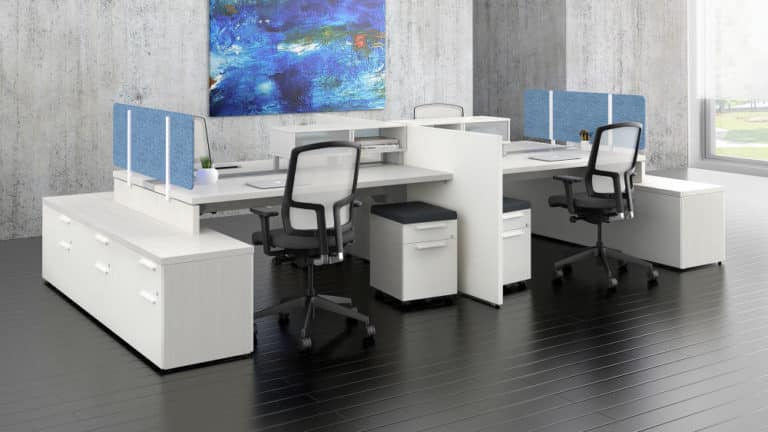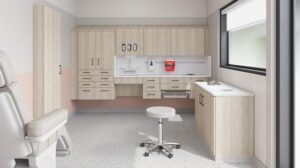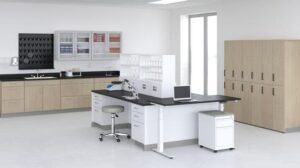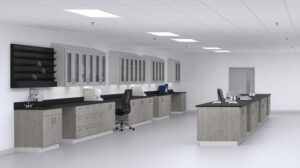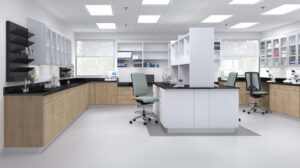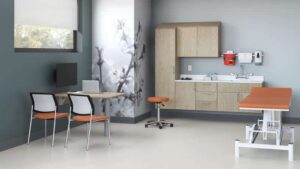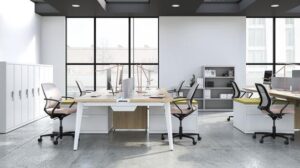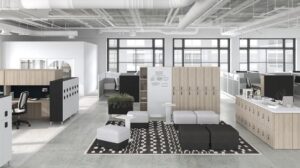As you enter your company workplace, you might wonder – What’s new in modern corporate interior design? As organizations strive to create environments where everyone can do their best work, the power of modular furniture in office interior design and corporate interior design stands out. But is it worth it?
Modular furniture isn’t just about flexibility—it’s about crafting spaces that adapt to every employee, from seasoned leaders to new recruits, introverts to extroverts, and everyone in between. Let’s explore how specific modular pieces—like height adjustable desks, occasional tables, lounge chairs, collaborative tables, lockers, and stacking chairs—can transform a workplace into a truly inclusive, productive, and inspiring environment.
Height Adjustable Desks and Tables: Empowering Individual Choice
The rise of height adjustable desks is a revolution in office interior design and corporate interior design. These desks allow employees to switch seamlessly between sitting and standing, supporting better posture, circulation, and energy levels. Research shows that height adjustable desks boost productivity and concentration, with 65% of users reporting increased focus and energy after a year of use. For companies, this means fewer absences and higher morale, as employees feel their well-being is valued.
Height adjustable desks are a cornerstone of modular furniture because they give every employee control over their workspace. In a multi-generational office, this is crucial. Older employees can reduce back and neck pain by standing more often, while younger workers appreciate the ability to move and stay active throughout the day. In hot-desking environments, app-powered desks can remember individual settings, so anyone can walk up and work comfortably. This flexibility is the essence of adaptive office interior design—meeting each person’s needs without compromise.
Occasional Tables: Versatile Anchors for Every Space
Occasional tables are the unsung heroes of modular furniture in the workplace. These movable, multi-purpose tables can serve as coffee tables, lamp stands, or display surfaces, and they’re perfect for filling awkward gaps or creating welcoming nooks. In office interior design, occasional tables can be used to anchor lounge areas, support impromptu meetings, or display company achievements and greenery for a touch of biophilia.
For diverse teams, occasional tables are invaluable. They provide a spot for a quick chat, a collaborative huddle, or a quiet coffee break. Their flexibility means they can be rearranged to suit the day’s needs, supporting both introverts seeking solitude and extroverts craving connection. In corporate interior design, occasional tables help create a balanced, harmonious office that feels both lived-in and professional.
Lounge Chairs: Comfort, Collaboration, and Calm
Lounge chairs are a staple of modular furniture that bring comfort and versatility to any office. Their ergonomic design supports relaxation and stress relief, making them ideal for break areas or wellness zones. In office interior design, lounge chairs are perfect for informal meetings, brainstorming sessions, or simply offering a change of scenery from the desk.
What makes lounge chairs so powerful in corporate interior design is their ability to foster creativity and teamwork. Arranged in clusters, they create inviting, non-hierarchical spaces where everyone’s voice is heard. This relaxed seating style breaks down barriers and encourages open dialogue, making it easier for employees from different backgrounds and generations to connect. For those who need a moment of solitude, a well-placed lounge chair in a quiet corner offers a personal retreat.
Collaborative Tables: Bringing Teams Together
Collaboration is at the heart of effective office interior design and corporate interior design. Modular collaborative tables are designed to bring people together, whether for project work, brainstorming, or training sessions. These tables can be reconfigured for large group meetings or split into smaller units for breakout discussions, adapting to the needs of any team.
Collaborative tables are especially valuable in offices with a mix of remote and in-person workers. Integrated technology—like built-in power outlets, screens, or video conferencing tools—makes hybrid collaboration seamless. For younger employees, these tables support agile, project-based work, while older employees appreciate the structure and organization they bring. In every case, collaborative tables embody the spirit of modular furniture: flexible, inclusive, and ready for anything.
Lockers and Storage: Order, Security, and Style
As open-plan offices become the norm, personal storage is more important than ever. Modern lockers are a key piece of modular furniture that blends seamlessly into office interior design and corporate interior design. Today’s lockers are sleek, customizable, and can even serve as space dividers, helping to define zones within an open office.
Lockers offer secure, accessible storage for laptops, documents, and personal items, supporting flexible work arrangements like hot-desking and hybrid schedules. For employees who value privacy and organization, lockers reduce clutter and create a sense of ownership. In a diverse workplace, lockers can be tailored to different needs—larger units for those with more gear, smaller ones for minimalists. Integrated into benches or under desks, lockers maximize space without sacrificing style.
Stacking and Nesting Chairs: Adaptability on Demand
Stacking and nesting chairs are the ultimate expression of modular furniture adaptability. These lightweight, movable chairs can be set up for conferences, training sessions, or team meetings, then quickly stacked or nested away when not in use. In office interior design, they make it easy to switch between large gatherings and open floor plans.
For a workplace with varied demographics, stacking and nesting chairs are a game-changer. They accommodate guests, support pop-up events, and provide flexible seating for employees who prefer to move around. In corporate interior design, these chairs help maintain a clean, organized look while ensuring the office can adapt to any occasion.
Modular Furniture: The Inclusive Foundation
What ties all these pieces together is the philosophy of modular furniture—designing for change, diversity, and inclusion. In both office interior design and corporate interior design, modular furniture empowers employees to shape their environment, supporting physical comfort, collaboration, and well-being for all ages and backgrounds. From height adjustable desks that boost health and productivity, to lounge chairs that foster creativity, to lockers that keep the office tidy, modular solutions are the key to a truly adaptive workplace.
Key Takeaways
- Height adjustable desks and tables empower employees to control their work experience and support health across all demographics.
- Occasional tables and lounge chairs create versatile, welcoming spaces for collaboration, relaxation, and individual focus.
- Collaborative tables and modular seating foster teamwork, creativity, and agile work, adapting to any group size or task.
- Lockers and modular storage keep open offices organized, secure, and clutter-free, supporting flexible work arrangements.
- Stacking and nesting chairs provide instant adaptability for meetings, events, and changing team needs.
- Modular furniture is the foundation of inclusive, future-proof office interior design and corporate interior design.
The Bottomline
Ergonomic furniture is the secret ingredient for creating inclusive, agile, and inspiring workplaces. By integrating height adjustable desks, occasional tables, lounge chairs, collaborative tables, lockers, and stacking chairs into your office interior design and corporate interior design, you create a space where every employee can thrive—no matter their background, age, or work style. In the evolving world of work, modular furniture ensures your office is always ready for what’s next.
Frequently Asked Questions (FAQ):
How does modular furniture support different employee demographics in office interior design?
Modular furniture adapts to varied needs, allowing employees of all ages and work styles to personalize their workspace, collaborate, or find privacy as needed.
What are the advantages of height adjustable desks in corporate interior design?
Height adjustable desks improve posture, boost energy, and give employees control, supporting health and productivity for everyone, regardless of age or physical ability.
Why are lockers and stacking chairs important in modern office interior design?
Lockers provide secure, personalized storage in open-plan offices, while stacking chairs offer flexible, space-saving seating for meetings and events, making the workplace more adaptable.
